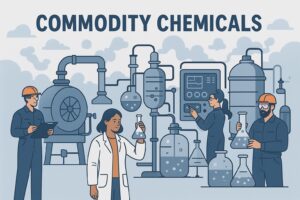| Rain Industries Ltd |
Carbon materials & advanced materials; also cement in India |
Calcined Petroleum Coke (CPC), Coal Tar Pitch (CTP), advanced carbon products (naphthalene derivatives, resins), (legacy) cement |
Aluminum smelting, electrodes, specialty resins, construction |
Globally diversified (plants in NA/EU/India) |
Spread business tied to aluminum & steel cycles; margins swing with raw material (green coke, coal tar), energy & freight; scale + integration are key |
| Chembond Material Technologies Ltd |
Specialty chemicals mid/small-cap |
Water treatment chemicals, construction chemicals, protective coatings, adhesives; niche industrial biotech |
Infra/municipal water, industrial utilities, construction, automotive/packaging |
India-heavy with select exports |
Fragmented markets; mix of tender/contract + B2B; value from technical service, distribution, and local customization |
| Clean Science & Technology Ltd |
Green-process specialty chemicals |
Performance chemicals (MEHQ, BHA, BHT), pharma intermediates (4‑MAP), anisole derivatives; process innovation focus |
Personal/home care, food antioxidants, pharma, agrochem |
Global exports meaningful |
Cost leadership from continuous-flow and proprietary catalysts; high yields, low effluents → strong margins; product concentration a watch |
| Galaxy Surfactants Ltd |
Surfactants & performance formulations |
Oleochemical & specialty surfactants, blends; mild surfactants |
FMCG—personal & home care (skin, hair, detergents) |
India + Rest of Asia + Africa/Middle East + some US/EU |
Sticky B2B with FMCG giants; customization + reliability beats pure price; relatively steady demand; RM (lauric oils, petro) pass-through with lag |
| Gujarat Fluorochemicals (GFL) |
Fluorochemicals & fluoropolymers |
PTFE, FKM, PVDF, ETFE, refrigerants; new-age fluoropolymers |
Industrial, auto/EV, chemical processing, solar, batteries, electronics |
Export-heavy |




